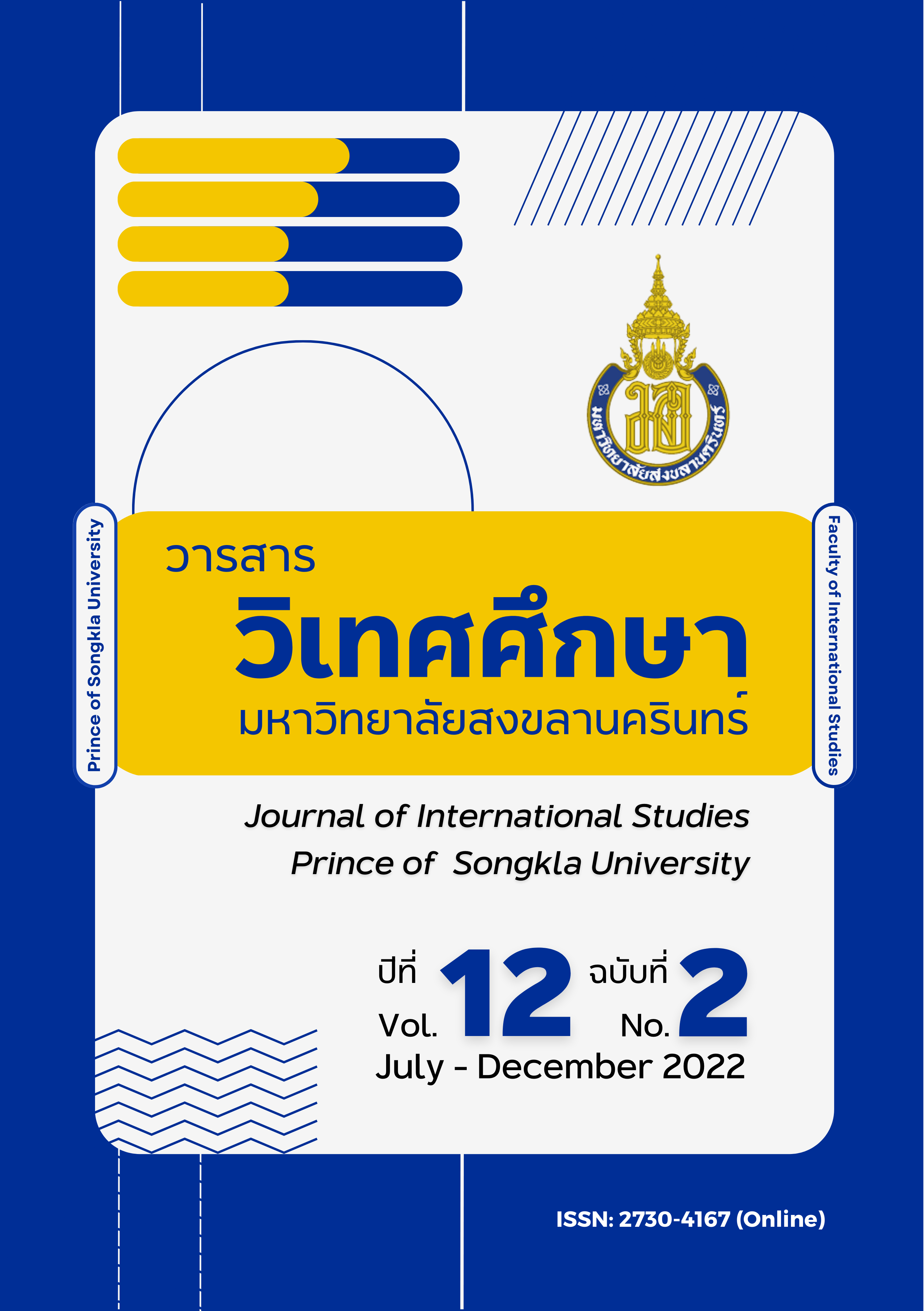Exploring MICE travelers’ desires and perception on marketing mix factors (7Ps) towards community-based MICE activities
Main Article Content
Abstract
This study aims to explore Thai MICE travelers’ desires and perception on Marketing Mix Factors (7Ps) towards community-based MICE activities. A mixed research method was employed in this research. The sample size is 318 Thai MICE travelers. The data collecting instrument was a questionnaire with the use of frequency, percentage, mean, and standard deviation, and followed by independent t–test statistics. Also, In-depth interviews were used to collect detailed information beyond initial surveyed answers.
The findings reveal that 1) most of the Thai MICE travelers prefer experiential community-based tourism activity, but least in luxurious activity 2) Thai MICE travelers who have different personal factor in gender, age, and type of organization desire differently in community-based MICE activities at the 0.005 significant level. Explicitly, female travelers desire food related activity, and wellness activity than male travelers; younger travelers desire adventure, but older travelers desire wellness activity; MICE travels from public sector desire historical and cultural activity as well as adventure than MICE travelers from private sector. 3) Nevertheless, the finding reveals insignificance on personal factor towards the Marketing Mix Factors (7Ps).
Article Details

This work is licensed under a Creative Commons Attribution-NonCommercial-NoDerivatives 4.0 International License.
Statements and opinions expressed in articles herein are those of the authors and do not necessarily reflect the position of the editors or publisher.
Article, information, text, image, etc. which are published in Journal of International Studies, belong to Journal of International Studies. If anybody or any organization would like to use part or whole of them, they must receive written permission from Journal of International Studies before usage.
References
ชัชชญา ยอดสุวรรณ. (2562). การพัฒนาศักยภาพและขีดความสามารถอุตสาหกรรมการจัดประชุมองค์กรและประชุมวิชาชีพของจังหวัดเชียงราย. สำนักงานคณะกรรมการวิจัยแห่งชาติ (วช.) และสำนักงานกองทุนสนับสนุนการวิจัย (สกว). https://elibrary.trf.or.th/fullP/RDG60T0032/RDG60T0032V01/RDG60T0032V01_full.pdf
ณัฐกานต์ รัตนพันธุ์, พัชราภรณ์ บุญเลื่อง, และอรทัย พงศ์เชี่ยวบุญ. (2560). สงขลาเมืองแห่งไมซ์ เพื่อรองรับกลุ่มการท่องเที่ยว IMT-GT. วารสารบริหารธุรกิจและการบัญชี มหาวิทยาลัยขอนแก่น, 1(1), 66-78. https://so04.tci-thaijo.org/index.php/kkbsjournal/article/view/161202
นิมิต ซุ้นสั้น. (2561). ปัจจัยที่มีอิทธิพลต่อการเลือกสถานที่จัดงานประชุม ในบริบทห้องประชุมโรงแรม: มุมมองผู้จัดงาน. วารสารวิชาการคณะบริหารธุรกิจ มหาวิทยาลัยเทคโนโลยีราชมงคลธัญบุรี, 13(2), 67-78. https://so03.tci-thaijo.org/index.php/RMUTT-Gber/article/view/241487
ปัญญาฤทธิ์ ทองกลิ่น. (2562). การศึกษาพฤติกรรมของนักเดินทางไมซ์ และระดับความคิดเห็นต่อปัจจัยส่วนประสมทางการตลาด กรณีศึกษา งานแสดงสินค้า Summer Bitter Sweet 2018 [สารนิพนธ์บริหารธุรกิจมหาบัณฑิต สาขาวิชาบริหารธุรกิจ]. มหาวิทยาลัยสงขลานครินทร์.
http://kb.psu.ac.th/psukb/handle/2016/13094
เพชรา บุดสีทา. (2556). การจัดการทางการตลาดการท่องเที่ยวชุมชนนครชุม จังหวัดกำแพงเพชร. สักทอง วารสารมนุษยศาสตร์และสังคมศาสตร์ มหาวิทยาลัยราชภัฏกำแพงเพชร, 16(1), 44-59. https://so05.tci-haijo.org/index.php/tgt/article/view/8001
เพ็ญนภา เพ็งประไพ. (2559). ปัจจัยส่วนประสมทางการตลาดที่มีอิทธิพลต่อความต้องการของนักท่องเที่ยวชาวไทยและต่างชาติในกิจกรรม การท่องเที่ยวเชิงสังคมและวัฒนธรรมของเกาะพะงัน จังหวัดสุราษฎร์ธานี [การค้นคว้าอิสระศิลปศาสตรมหาบัณฑิต สาขาวิชาอุตสาหกรรรมการบริการและการท่องเที่ยว]. มหาวิทยาลัยกรุงเทพ. http://dspace.bu.ac.th/bitstream/123456789/ 2038/1/pennapa_peng.pdf
ยุทธ ไกยวรรณ์. (2550). การสร้างเครื่องมือวิจัย. กรุงเทพฯ: ศูนย์สื่อเสริมกรุงเทพฯ.
ศิวธิดา ภูมิวรมุนี, และอลิศรา ธรรมบุตร. (2564). ปัจจัยส่วนประสมด้านการตลาดการท่องเที่ยวโดยชุมชน กรณีศึกษาหมู่บ้านช้าง ตำบล กระโพ อำเภอท่าตูม จังหวัดสุรินทร์, วารสารศิลปศาสตร์ราชมงคลสุวรรณภูมิ, 3(3), 226-240. https://so03.tci-thaijo.org/index.php/art/article/view/ 253590
สุธิรา ปานแก้ว. (2558). แนวทางการจัดการตลาดอุตสาหกรรมไมซ์ของอำเภอหาดใหญ่ จังหวัดสงขลา. [วิทยานิพนธ์บริหารธุรกิจมหาบัณฑิต สาขาวิชาการจัดการการท่องเที่ยว]. มหาวิทยาลัย สงขลานครินทร์. https://kb.psu.ac.th/psukb/bitstream/2010/10168/ 1/404567.pdf
สำนักงานคณะกรรมการพัฒนาการเศรษฐกิจและสังคมแห่งชาติ. (2560, 2 กุมภาพันธ์). แผนพัฒนาเศรษฐกิจและสังคมแห่งชาติ ฉบับที่ 12 พ.ศ. 2560 - 2564. สำนักงานสภาพัฒนาเศรษฐกิจและสังคมแห่งชาติ. https://www.nesdc.go.th/ewt_news.php?nid= 6420&filename=develop_issue
สำนักงานส่งเสริมการจัดประชุมและนิทรรศการ. (2559). Introduction to MICE Industry. กรุงเทพฯ: สำนักงานส่งเสริมการจัดประชุมและนิทรรศการ (องค์การมหาชน).
สำนักงานส่งเสริมการจัดประชุมและนิทรรศการ. (2560). อุตสาหกรรมไมซ์ ในภูมิภาคเอเชีย. กรุงเทพฯ: สำนักงานส่งเสริมการจัดประชุมและนิทรรศการ (องค์การมหาชน).
สำนักงานส่งเสริมการจัดประชุมและนิทรรศการ. (2561). MICE ไม่ได้แปลว่าหนู. กรุงเทพฯ: สำนักงานส่งเสริมการจัดประชุมและนิทรรศการ (องค์การมหาชน).
สำนักงานส่งเสริมการจัดประชุมและนิทรรศการ. (2562ก). โครงการศึกษาและวิเคราะห์ศักยภาพของอุตสาหกรรมไมซ์ภายในประเทศ (7 รูปแบบกิจกรรมไมซ์). https://elibrary.tceb.or.th/
สำนักงานส่งเสริมการจัดประชุมและนิทรรศการ. (2562ข). คู่มืออบรมบริษัทรับจัดการธุรกิจไมซ์ภายในประเทศ. กรุงเทพฯ: สำนักงานส่งเสริมการจัดประชุมและนิทรรศการ (องค์การมหาชน).
สำนักงานส่งเสริมการจัดประชุมและนิทรรศการ. (2563). รายงานสถิติอุตสาหกรรมไมซ์ ประจำปีงบประมาณ 2563. https://elibrary.tceb.or.th/
สำนักงานส่งเสริมการจัดประชุมและนิทรรศการ. (2564ก). คู่มือไมซ์เพื่อชุมชน. https://www.businesseventsthailand.com/th
สำนักงานส่งเสริมการจัดประชุมและนิทรรศการ. (2564ข). รายงานผลการดำเนินงานครึ่งปีงบประมาณ 2564 (ตุลาคม 2563 ถึง มีนาคม 2564). https://www.businesseventsthailand.com/uploads /press_media/file/210603-file-WcjJ3BfOw. pdf
สำนักงานส่งเสริมการจัดประชุมและนิทรรศการ. (2564ค). ไมซ์เพื่อชุมชน-ชวนชาวไมซ์ส่งเสริมชุมชนทั่วไทย. https://elibrary.tceb.or.th/th/Publication/MICE-for Community/6215?aliaspath=%2FPublication%2FMICEfor-Community%2F6215
อนันต์ สุนทราเมธกุล, เจริญ โสภา, และภีม พรประเสริฐ. (2557). ปัจจัยที่มีอิทธิพลต่อพฤติกรรมการท่องเที่ยวของนักท่องเที่ยวกลุ่มไมซ์ในจังหวัดอุบลราชธานี. วารสารการบริการและการท่องเที่ยวไทย, 9(1), 3-17. https://so04.tci-thaijo.org/index.php/ tourismtaat/article/view/19773
อัศวิน แสงพิกุล. (2562). ระเบียบวิธีวิจัยด้านการท่องเที่ยวและการโรงแรม. กรุงเทพฯ: สำนักพิมพ์จุฬาลงกรณ์มหาวิทยาลัย.
อารีรัตน์ ไชยช่อฟ้า. (2558). ความพร้อมทางการตลาดสำหรับธุรกิจการจัดประชุม เพื่อรองรับ AEC ของอำเภอหาดใหญ่ จังหวัดสงขลา [วิทยานิพนธ์บริหารธุรกิจมหาบัณฑิต สาขาวิชาการจัดการการท่องเที่ยว]. มหาวิทยาลัยสงขลานครินทร์. https://kb.psu.ac.th/psukb/bitstream/2010/9876/ 1/394889%20.pdf
อารััญ บุุญชััย. (2565). รายงานภาวะเศรษฐกิจการท่องเที่ยว. กองเศรษฐกิจการท่องเที่ยวและกีฬา. ปีที่ 3. ฉบับที่ 1/2565. https://www.mots.go.th/images/v2022_1655221882491djIwMjJfMTY1NTIwMTMzOTMyNeC4o+C4suC4ouC4h+C4suC4meC4oOC4suC4p+C4sOC5gOC4qOC4o+C4qeC4kOC4geC4tOC4iOC4geC4suC4o+C4l+C5iOC4reC4h+C5gOC4l+C4teC5iOC4ouC4pyDguJvguLXguJfguLXguYggMyDguInguJrguLHguJrguJfguLXguYggMS0yNTY1LnBkZg==.pdf
Alananzeh, O., Badarneh, M. A., Mkhadmeh, A. A., & Jawabreh, O. (2019). Factors influencing MICE tourism stakeholders' decision making: The case of Aqaba in Jordan. Journal of Convention & Event Tourism, 20(1), 24-43.
Alananzeh, O., Maaiah, B., Al-Badarneh, M., & Al-Shorman, A. (2017). The geographic distribution of conferences in Jordan from 2014 to 2016 using predictive GIS modeling. Journal of Convention & Event Tourism, 19(2), 167–185.
Alananzeh, O., Mkhadmeh, A. A., Shatnawi, H. S., & Masadeh, R. (2022). Event as a tool for community involvement and sustainable regional development: The mediating role of motivation on community attitudes. Journal of Convention & Event Tourism, 23(4), 297-317.
Booms, B. H., & Bitner, M. J. (1981). “Marketing strategies and organization structures for service firms”. In J.H. Donnelly & W.R. George (Eds), Marketing of services (pp. 47 – 51). American Marketing Association. Chicago, IL.
Cronbach, L. J. (1974). Essentials of psychological testing. (3rd ed). New York: Harper & Row.
Crouch, G. I., & Ritchie, J. R. B. (1998). Convention site selection research: A review, conceptual model, and propositional framework. Journal of Convention and Exhibition Management, 1(1), 49-69.
Davidson, R. (1994). Business Travel. London: Addison Wesley Longman.
Hoonakker, P. L. T., & Carayon, P. (2009). Questionnaire survey nonresponse: A comparison of postal mail and Internet surveys. International Journal of Human Computer Interaction (IJHJI), 25(5), 348-373.
Kline, R. B. (2015). Principles and practice of structural equation modeling (4th ed.). New York: Guildford Press.
Kotler, P., & Keller, K. L. (2009). Marketing management. New Jersey: Pearson Prentice Hall.
Linderman, R. H., Merenda, P. F., & Gold, R. Z. (1980). Introduction to bivariate and multivariate analysis. Glenview, IL.: Scott, Foresman.
Lovelock, C., Wirtz, J., & Chew, P. (2011). Essentials of services marketing. Singapore: Prentice Hall.
Mitchell, R. E., & Reid, D. G. (2001). Community integration: Island tourism in Peru. Annals of Tourism Research, 28(1), 113–139.
Mykhailichenko, H., Kravtsov, S., & Zabaldina, Y. (2020). Planning of event portfolio for tourism destination in post-quarantine period. Herald of Kyiv National University of Trade and Economics, 130(2), 36-47. http://dx.doi.org/ 10.31617/visnik.knute.2020(130)03
Pawaskar, P., & Goel, M. (2014). A Conceptual Model: Multisensory marketing and destination branding. Procedia Economics and Finance, 11, 255–267.
Swarbrooke, J., & Horner, S. (2001). Business travel and tourism. Oxford: Butterworth-Hienemann.
Yamane, T. (1973). Statistics: An introductory analysis (3rd ed). New York: Harper and Row.


